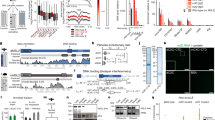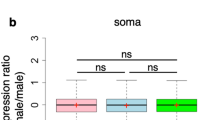Abstract
In Drosophila, compensation for the reduced dosage of genes located on the single male X chromosome involves doubling their expression in relation to their counterparts on female X chromosomes1. Dosage compensation is an epigenetic process involving the specific acetylation of histone H4 at lysine 16 by the histone acetyltransferase MOF2,3,4,5. Although MOF is expressed in both sexes, it only associates with the X chromosome in males. Its absence causes male-specific lethality6. MOF is part of a chromosome-associated complex comprising male-specific lethal (MSL) proteins and at least one non-coding roX RNA7. How MOF is integrated into the dosage compensation complex is unknown. Here we show that association of MOF with the male X chromosome depends on its interaction with RNA. MOF specifically binds through its chromodomain to roX2 RNA in vivo. In vitro analyses of the MOF and MSL-3 chromodomains indicate that these chromodomains may function as RNA interaction modules. Their interaction with non-coding RNA may target regulators to specific chromosomal sites.
This is a preview of subscription content, access via your institution
Access options
Subscribe to this journal
Receive 51 print issues and online access
$199.00 per year
only $3.90 per issue
Buy this article
- Purchase on Springer Link
- Instant access to full article PDF
Prices may be subject to local taxes which are calculated during checkout




Similar content being viewed by others
References
Lucchesi, J. C. Dosage compensation in flies and worms: the ups and downs of X- chromosome regulation. Curr. Opin. Genet. Dev. 8, 179 –184 (1998).
Turner, B. M. Histone acetylation as an epigenetic determinant of long-term transcriptional competence. Cell. Mol. Life Sci. 54, 21– 31 (1998).
Bone, J. R. et al. Acetylated histone H4 on the male X chromosome is associated with dosage compensation in Drosophila. Genes Dev. 8, 96–104 (1994).
Akhtar, A. & Becker, P. B. Activation of transcription through histone H4 acetylation by MOF, an acetyl transferase essential for dosage compensation in Drosophila. Mol. Cell 5, 367–375 (2000).
Smith, E. R. et al. The Drosophila MSL complex acetylates histone H4 at lysine 16, a chromatin modification linked to dosage. Mol. Cell. Biol 20, 312–318 ( 2000).
Hilfiker, A., Hilfiker-Kleiner, D., Pannuti, A. & Lucchesi, J. C. Mof, a putative acetyl transferase gene related to the Tip60 and MOZ human genes and to the SAS genes of yeast, is required for dosage compensation in Drosophila. EMBO J. 16, 2054– 2060 (1997).
Lucchesi, J. C. Dosage compensation: roX marks the spot. Curr. Biol. 9, R807–R808 (1999).
Meller, V. H., Wu, K. H., Roman, G., Kuroda, M. I. & Davis, R. L. roX1 RNA paints the X chromosome of male Drosophila and is regulated by the dosage compensation system. Cell 88, 445–457 (1997).
Amrein, H. & Axel, R. Genes expressed in neurons of adult male Drosophila. Cell 88, 459– 469 (1997).
Kelley, R. L. et al. Epigenetic spreading of the Drosophila dosage compensation complex from roX RNA genes into flanking chromatin. Cell 98, 513–522 (1999).
Copps, K. et al. Complex formation by the Drosophila MSL proteins: role of the MSL-2 RING finger in protein complex assembly. EMBO J. 17, 5409–5417 (1998).
Merendino, L., Guth, S., Bilbao, D., Martinez, C. & Valcarcel, J. Inhibition of msl-2 splicing by Sex-lethal reveals interaction between U2AF35 and the 3′ splice site AG. Nature 402, 838–841 (1999).
Richter, L., Bone, J. R. & Kuroda, M. I. RNA-dependent association of the Drosophila maleless protein with the male X chromosome. Genes Cells 1, 325–336 (1996).
Stuckenholz, C., Kageyama, Y. & Kuroda, M. I. Guilt by association: non-coding RNAs, chromosome-specific proteins and dosage compensation in Drosophila. Trends Genet. 15, 454–458 ( 1999).
Meller, V. H. et al. Ordered assembly of roX RNAs into MSL complexes on the dosage-compensated X chromosome in Drosophila. Curr. Biol. 10, 136–143 (2000).
Franke, A. & Baker, B. S. The rox1 and rox2 RNAs are essential components of the compensasome, which mediates dosage compensation in Drosophila. Mol. Cell 4, 117– 122 (1999).
Weeks, K. Protein-facilitated RNA folding. Curr. Opin. Struct. Biol. 7, 336–342 (1997).
Ivanova, A. V., Bonaduce, M. J., Ivanov, S. V. & Klar, A. J. The chromo and SET domains of the Clr4 protein are essential for silencing in fission yeast. Nature Genet. 19, 192– 195 (1998).
Ball, L. J. et al. Structure of the chromatin binding (chromo) domain from mouse modifier protein. EMBO J. 16, 2473– 2481 (1997).
Bunch, T. A., Grinblat, Y. & Goldstein, L. S. Characterization and use of the Drosophila metallothionein promoter in cultured Drosophila melanogaster cells. Nucleic Acids Res. 16, 1043– 1061 (1988).
Koonin, E. V., Zhou, S. & Lucchesi, J. C. The chromo superfamily: new members, duplication of the chromo domain and the possible role in delivering transcription regulators to chromatin. Nucleic Acids Res. 23, 4229 –4233 (1995).
Gu, W., Szauter, P. & Lucchesi, J. C. Targeting of MOF, a putative histone acetyl transferase, to the X chromosome of Drosophila melanogaster. Dev. Genet. 22, 56–64 ( 1998).
Pirrotta, V. Polycombing the genome: PcG, TrxG, and chromatin silencing. Cell 93, 333–336 ( 1998).
Jones, D. O., Cowell, I. G. & Singh, P. B. Mammalian chromodomain proteins: their role in genome organisation and expression. BioEssays 22, 124–137 (2000).
Smothers, J. F. & Henikoff, S. The HP1 chromo shadow domain binds a consensus sequence pentamer. Curr. Biol. 10, 27–30 ( 2000).
Messmer, S., Franke, A. & Paro, R. Analysis of the functional role of the polycomb chromo domain in Drosophila melanogaster. Genes Dev. 6, 1241–1254 (1992).
Lanz, R. B. et al. A steroid receptor coactivator, SRA, functions as an RNA and is present in an SRC-1 complex. Cell 97, 17–27 (1999).
Eddy, S. Noncoding RNA genes. Curr. Opin. Genet. Dev. 9, 695–699 (1999).
Panning, B. & Jaenisch, R. RNA and the epigenetic regulation of X chromosome inactivation. Cell 93, 305 –308 (1998).
Eils, R. et al. Three-dimensional reconstruction of painted human interphase chromosomes: active and inactive X chromosome territories have similar volumes but differ in shape and surface structure. J. Cell. Biol. 135, 1427–1440 (1996).
Acknowledgements
A.A. acknowledges support from the Human Frontier Science Program. We thank M. Kuroda for providing antibodies; T. Straub for GST control protein; D. Ostareck and G. Mengus for protocols; I. Vetter and C. Schwarzlose for technical assistance; and N. Sadoni for help with arranging images. We are also grateful to W. Hörz, S. Kass and members of the laboratory for critical reading of the manuscript and helpful discussion.
Author information
Authors and Affiliations
Corresponding author
Supplementary Information
Rights and permissions
About this article
Cite this article
Akhtar, A., Zink, D. & Becker, P. Chromodomains are protein–RNA interaction modules. Nature 407, 405–409 (2000). https://doi.org/10.1038/35030169
Received:
Accepted:
Issue Date:
DOI: https://doi.org/10.1038/35030169
This article is cited by
-
Genome-wide analysis and functional annotation of chromatin-enriched noncoding RNAs in rice during somatic cell regeneration
Genome Biology (2022)
-
CBX8 acts as an independent RNA-binding protein to regulate the maturation of miR-378a-3p in colon cancer cells
Human Cell (2021)
-
The many lives of KATs — detectors, integrators and modulators of the cellular environment
Nature Reviews Genetics (2019)
-
Chromatin-associated RNAs as facilitators of functional genomic interactions
Nature Reviews Genetics (2019)
-
The Chp1 chromodomain binds the H3K9me tail and the nucleosome core to assemble heterochromatin
Cell Discovery (2016)
Comments
By submitting a comment you agree to abide by our Terms and Community Guidelines. If you find something abusive or that does not comply with our terms or guidelines please flag it as inappropriate.



